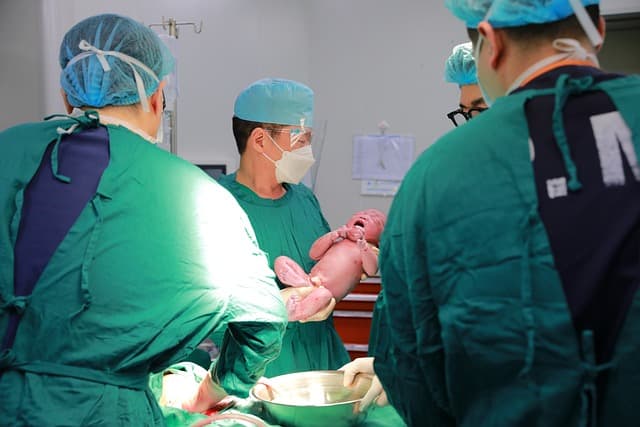According to statistics, every seventh woman in the world faces postpartum depression. Symptoms usually appear within six weeks after the birth of a child.
What problems can arise after childbirth?
Six weeks after the birth of a child is called the postpartum period, when the mother’s body returns to the state it was in before pregnancy. During this period, women may feel irritable, moody, have difficulty concentrating, or have trouble sleeping. Mood changes usually resolve within seven to ten days. If the symptoms of increased emotionality and sadness last for more than two weeks or interfere with caring for the child, new mothers may be diagnosed with postpartum depression.
Types of postpartum disorders
Childbirth is a difficult process that is accompanied by physical and hormonal changes. Types of postpartum disorders:
- Baby blues. A melancholic state that occurs in the first two to three days after childbirth and lasts no longer than two weeks. It is manifested by mood swings, sudden crying for no apparent reason, anxiety, and insomnia, and it resolves on its own and does not require treatment;
- Postpartum depression. Most often it has a long course, and symptoms can progress if left untreated;
- Postpartum psychosis. A severe form of depression that occurs in one woman out of 1000. Symptoms usually appear immediately after childbirth and last from two to three weeks to several months.
If you have signs of postpartum depression, you need to consult a psychotherapist. The doctor will conduct an examination, analyze complaints, refer you for tests and instrumental studies if necessary, and, based on the results of the diagnosis, select a course of therapy.
What is postpartum depression?
Postpartum depression is a disease that can develop in women after childbirth. It can lead to changes in the emotional state (mood swings, anxiety, and irritability) and physical symptoms (headaches, insomnia). The disorder has a negative impact on the woman, her partner, and the child.
Causes of postpartum depression
The nature of postpartum disorders is not fully understood. Possible causes of postpartum depression are hormonal changes: a drop in estrogen and progesterone, fluctuations in thyroid hormones – thyroxine and triiodothyronine. Factors contributing to the development of postpartum depression
- hereditary predisposition;
- lack of social support (for example, from a husband or parents);
- conflicts in marriage or relationships;
- difficult or premature labor;
- emergency cesarean section;
- complications during childbirth (umbilical cord prolapse, meconium aspiration syndrome);
- early childbirth (under 20 years of age);
- birth of a child with special needs (for example, in the presence of diseases or developmental pathologies);
- mental illness (bipolar disorder, schizophrenia);
- stressful events during pregnancy (separation from a loved one, job loss, illness or death of a relative);
- problems with breastfeeding (refusal of the infant to feed, insufficient milk supply);
- multiple pregnancy;
- financial problems;
- unwanted or unplanned pregnancy;
- sexual violence.
Smoking during pregnancy is also a risk factor for depression. Nicotine contained in tobacco smoke affects the central nervous system and can change the chemical balance in the brain. As a result, the level of neurotransmitters (serotonin and dopamine), which play a key role in regulating mood and emotional state, changes.
Postpartum psychosis is more likely to develop in women after the first birth, and recurs only in 30-50% of cases. Causes of postpartum psychosis:
- lack of sleep;
- autoimmune diseases;
- inflammatory process in the body;
- deficiency of vitamins B1 and B12;
- pathologies of the thyroid gland;
- electrolyte imbalance;
- stroke (cerebral circulation disorder).
Pathologies during pregnancy can contribute to the development of postpartum psychosis: preeclampsia (high blood pressure) and eclampsia (transverse muscle cramps). Risk factors include overweight, bronchial asthma, and diabetes mellitus.
Treatment methods for postpartum depression
A psychiatrist will help you get rid of postpartum depression after determining the severity, symptoms, and duration of the disease. Treatment of depression after childbirth:
- Tricyclic antidepressants. After childbirth, antidepressants help to stabilize mood, reduce anxiety, and improve a woman’s emotional state;
- selective serotonin reuptake inhibitors. Increase the level of serotonin in the brain, improving the transmission of nerve impulses in the central nervous system. They help improve mood and reduce symptoms of depression by affecting the chemical balance in the brain;
- norepinephrine reuptake inhibitors. Increase the level of norepinephrine, enhancing its effect in the brain;
- sedatives. Enhance the effect of gamma-aminobutyric acid (a neurotransmitter in the brain), which leads to a sedative effect and reduced anxiety.
Antidepressants prescribed for postpartum depression can be passed to the baby during feeding. However, the doses of medications in breast milk are minimal and safe for the baby, so there is no need to stop natural feeding (unless otherwise prescribed by a psychotherapist). The type and dosage of pills for the treatment of postpartum depression is selected individually for each patient.
Treatment for postpartum depression also includes psychotherapy sessions. The therapist helps to identify and resolve problems in relationships, supports the mother’s adaptation to a new role, and helps to restore and strengthen mental health.
Antidepressants, antipsychotic drugs, mood stabilizers, and benzodiazepines are commonly prescribed for the treatment of postpartum psychosis. The patient may also be prescribed electroconvulsive therapy, a procedure during which small electric currents are passed through the brain, causing controlled seizures. The therapy affects the parts of the brain responsible for emotions and mood, helping to cope with the signs of psychosis.



